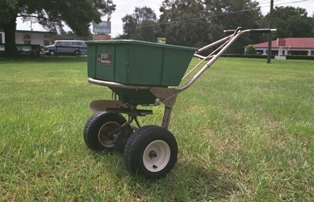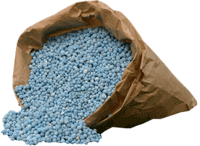
Fertilizers are manufactured from a wide variety of materials to supply plant nutrients. Once these materials are mixed, it becomes difficult to distinguish the materials present. In the past, a few unscrupulous manufacturers have taken advantage of this to increase their profit. To protect consumers and legitimate manufacturers from such practices, The Florida legislature enacted the first fertilizer law in 1889 and has amended it many times since enactment. These laws regulate the manufacture and sale of fertilizer in the state.
The law requires that the manufacturer purchase and affix a label to each bag, package, container, or lot of fertilizer offered for sale in the state. The law requires that each label show specific information about the analysis and composition of the mixture or material.

The key information comes in the guaranteed analysis section of the label. It tells the home gardener the ratio by percentage of the primary plant nutrients. The number s are in the order of these primary nutrients; Nitrogen, Phosphorus and Potassium. For example an 8-8-8 fertilizer would be eight percent nitrogen compound, eight percent phosphorus compound and eight percent potassium compound.
There’s some other information in this section of the label that may seem even more complicated but it’s also important. The label explains how much chlorine the fertilizer can contain. Chlorine can reduce the quality of some vegetable and flowers.
It informs the buyer what materials the primary plant nutrients are derived from. This can assist in determining the quality of the fertilizer.
Probably the most difficult part of the label to read, certainly the hardest part to describe, is the information listed right after the total nitrogen figure in the guaranteed analysis section. In addition the total amount of nitrogen, the label gives the amount of each of several types of nitrogen present in the fertilizer. This information will seem confusing, but it also offers a glimpse into how the fertilizer will work in specific types of soil.
Terms such as nitrate nitrogen ammoniacal nitrogen, water-soluble organic nitrogen and/or urea nitrogen can be used by plants fairly quickly. These nitrogen forms in fertilizer are great for a vegetable garden. But nitrate and water-soluble organic nitrogen are rapidly leached out of the soil so they don’t last very long. Ammoniacal and water insoluble nitrogen will stay longer in sandy soils.
Fertilizer with a high percentage of natural organic nitrogen is used by the plants slowly over a fairly long period of time. This kind of slow release fertilizer would be good for lawns helping them stay green without causing spurts of extra fast growth.
This is a complicated subject, hard to fully explain in one article. This is the take home message: almost any fertilizer purchased in Florida is a good one if it has the ingredients required for plant health and if the price is fair in terms of the total amount of plant nutrients it contains.
For more information on Florida fertilizer label contact your local UF IFAS Extension office or read this publication on the Florida Fertilizer Label.
 0
0

Comments:
May 22, 2020
Merry, I never use salt when cooking rice and prefer to add a little bit of butter instead of olive oil because I like the taste butter imparts. However, neither olive oil nor butter are necessary for cooking rice. Another great way to cook rice is by using chicken broth instead of water. The finished rice has a delicious chicken flavor that can boost the overall richness of the final product. As for short- and medium-grain vs. long-grain rice, they are not created equal. You will generally not get the same results from short- or medium-grain rice as you will from long-grain rice, especially if a recipe specifically calls for long-grain rice. Long-grain rice, when cooked, is dry and loose, whereas short- and medium-grain rice is sticky and clumps together. For fried rice, long-grain is best. Short-grain rice is great for rice pudding and sushi, whereas medium-grain rice is best used for dishes such as risotto. Samantha Kennedy, M.S. Family and Consumer Sciences Agent UF/IFAS Extension Wakulla County
May 21, 2020
This is quite helpful. Being in self isolation quite a distance from home, I inevitably needed a culinary companion. This site has been the guide I so much needed. Cooking rice is the combination of art and science. I sometimes see chefs sprinkling salt and olive oil when preparing rice, what’s your take on this? And would you get the same results if you used short or medium grain variety?
August 19, 2016
Thanks for writing about organic gardening. More and more gardeners are turning to it, but there are still more to convince. I want to correct the notion that organic gardens require lots of work, particularly weeding. I practice a form of organic gardening that uses heavy mulches to suppress weeds. Mulches also protect the soil from burning up under our hot subtropical sun, promote beneficial microbial activity, and add organic matter to the soil when they eventually break down. This results in an average of about 5 minutes a month spent weeding a 1500 square foot garden. I'm guessing it takes quite a bit longer than that to spray poisonous herbicides over the same area. I've been using this method for over 17 years with wonderful results and would never go back to bare earth gardening.
July 18, 2016
I am not familiar with nurseries in Okaloosa County, but you should try calling the extension office located at 3098 Airport Road Crestview, FL 32539 Phone: (850) 689-5850 or email the horticulture agent Larry Williams lwilliams@co.okaloosa.fl.us
July 17, 2016
Where can I find a kumquat tree in Okaloosa County?
June 29, 2016
Hi Donna. For better results, zoysiagrass require frequent fertilization. Periodic soil testing should be conducted every 2 to 3 years as the basis for applications of lime and fertilization. Your local county extension office can help with your soil testing needs. Soil test results will help determine management measures, such as to maintain the proper soil pH between the desired range of 6.0 to 6.5 and keep the nitrogen, phosphorous, and potassium levels at recommended levels. For minimum maintenance, it is recommended to apply between 2 to 3 pounds of actual nitrogen per 1,000 square feet of zoysiagrass lawn per year in north Florida. To accomplish this, apply a complete fertilizer such as 16-4-8, 13-13-13, or10-10-10 at least three times a year in April, June, and August.
June 22, 2016
So what months should zoysia be fertilized and with what type fertilizer? I put it my small backyard a couple years ago.
May 1, 2016
Two green thumbs up! Old-timers here in Pensacola say you can pinch back azaleas 'til the Fourth of July and still get a good bloom; this works well for me. (They also say you should plant your potatoes and fertilize your rose bushes on Valentine's Day and that you can pinch back your poinsettias until Labor Day. This also works well for me as far as the rose bushes and poinsettias go. I haven't tried potatoes yet, but maybe I'll try planting some on Valentine's Day, 2017.)
March 20, 2016
Very well written article, and easy to follow http://www.lectiiapicultura.ro/
June 10, 2015
We know all about plants, but not about the law. You may want to consult a lawyer or state agency that deals with these issues. Good luck!
May 31, 2015
Can the HOA's stop you from having a small garden? There is nothing in the Master Documents that address this issue in particular.
May 28, 2015
Ants are also amazing. They aerate the soil, help with decomposition and waste removal, plant seeds, and are food for many birds and other animals. I'm all for getting rid of the invasive fire ants but I'd discourage people from killing the other ants in their yards.
August 20, 2014
Thanks for the timely article. One of the things I dislike about vacations is that I have to leave my plants unattended. I think the points you raised were just perfect. As to houseplants, I would only add that there are self-watering systems one can use as well. They’re better than nothing if you’re going to be away for an extended period of time. Richard www.naturehills.com
August 1, 2014
Hello Roy, My wife and I have been raising bees for about a year. As novice beekeepers we are seeking natural methods instead of the chemical practices you mentioned in the article to ensure a healthy hive in the spring. We are open to any suggestions you may have. Thank you in advance for your help. Brett
May 24, 2014
Great article but you did not mention soil Ph. I have quite a few daylilies but their foliage is slightly yellow. I have used a good fertilizer but wonder if the Ph is not right. Thanks for any information you can provide. Carolyn
November 8, 2013
am really happy for the services you offer to, to me am a student studying apiculture in uganda, am more interested in knowing how robbing occurs within on colony. thanks to you
November 6, 2013
William, thanks for your question. This is a common issue, since many folks apply fertilizer to centipede grass late in the year to green it up. Doing this does little or nothing for greening up the lawn and can actually harm the grass by encouraging growth when it is entering its dormant period. This can also encourage late season root rots. As a general rule, I would recommend the last application of fertilizer to Centipede and St. Augustine in mid September. Absolutely no ferteilzer should be applied after September 31st. For more information, take a look at this publication on Centipedegrass from UF IFAS Extension. Hope this helps, Matt
November 5, 2013
Mr. Carter- i work with the Florida Fish and Wildlife Commission and need to know when the best time to apply fall fertilizer to St. Augustine and Centipede grass; I learned in an earlier artical about the right time to apply lawn fertilizer for the spring is after the soil has warmed up...but didn't see anything mentioned about fall/winter applications. Your response is greatly appreciated. Thank you, William Doc Dockery
Comments are closed.